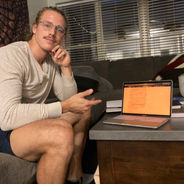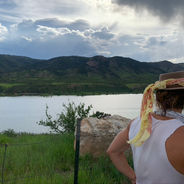Coming to One's Senses: What is neural plasticity?
- Christian Van Camp

- Mar 10, 2019
- 7 min read
Updated: Oct 24, 2020
Some people believe that the easiest way to simulate the disability of blindness is by simply closing their eyes, but it’s much more involved than that. It is estimated that 1.3 million blind people in the U.S. stroll around the busy and chaotic sidewalks using nothing more than a cane for guidance. A remarkable thing about their daily agenda is their utter fearlessness and confident behavior. They have one thing us sighted people lack—a unique structural change in brain matter that heightens other senses, such as hearing and touch.

One intelligent man that dealt with this mind transformation was John Hull. His experience of blindness exhibits the elastic aspect of the human brain in how it can rewire itself after a specific sensory system failure and compensate by enhancing other senses. Individuals with an impairment—such as blindness—experience a limitation in basic life activities; however, a sensory loss can be looked upon as a new beginning for other improved cognitive functions.
Blind individual’s initially tough and struggling livelihood eventually becomes manageable when their brains evolve to boost those needed senses—primarily hearing. In the Journal of Visual Impairment & Blindness, data collected from the years 1983-86 projected the number of blind people (in both eyes) to reach an average of 400,000 of the US population. Take into consideration this report is over 20 years ago—that number has exponentially grown. Nearly two-thirds of these blind people stated that they have “some limitation in social roles (going to school, work, etc.), including 38% needing help with basic life activities (eating, getting around, etc.) …” Thirty-eight percent of 400,000 people is roughly 150,000—or about a third of the blind society interviewed. This number appears surprisingly low and supports how the human brain follows this adaption response. There is no doubt that blindness, deafness, or even the lack of smell causes some structural and functional changes that enhance other sensory inputs. The other 250,000 blind people did not report struggle in their lives because they’re able to rely more on their improved hearing, smell, touch, and other senses for guidance.
John's early life was very troublesome and concerning for him. Hull grew up partly sighted and developed cataracts (clouding of eyes’ lens that obstructs passage of light) at 13 years old. Eventually, blindness took control of his left eye at 17 years old and his right eye remained decently clear until he was around 35. In 1983, the curtains finally shut at 48 years young. Although John's “sense of objects having appearances, or visible characteristics, vanished,” and “he could no longer conjure up the faces of his wife and children, or of familiar and loved landscapes and places,” he was able redefine who he was.
After becoming visionless, John dealt with the situation positively and let his brain unconsciously work the magic. His “senses assumed a new richness and power,” and escaped the blankness through his focus on sound. Not just any sound; but the sound of rain. He stated that the mere sound of raindrops amplified his surroundings in a way he never experienced before. This allowed him to interpret the entire landscape around him and grasp the difference between the path, lawn, or even the fence from his garden.
Blindness can be looked upon as a gift when you accept the unfortunate reality. Using the power of positive thinking, you can truly manipulate your physiological makeup. This bright outlook benefits the person and will strengthen the value of self; thus, leading to further sensory adaptation. He came to his senses after recognizing how intensified his auditory function became, and he emphasized that it wasn’t purely “compensation… but a whole new visual nostalgia, from the strain of falsity of trying to pass as ‘normal’, and [he] found a new focus, a new freedom and identity."
We all can ignite a more fulfilling life simply by accepting our present position. Whether its something minor like a sprained ankle, a broken bone, or even a headache, we have the power to repair, heal, & return to comfort. Us humans were designed to revitalize from traumas, yet this can be sped up more efficiently through the reinforcement of positivity.
Several human studies back-up this phenomenon of sensory compensation and indicate that blind individuals can perform nonvisual tasks better than the sighted. In the Canadian Journal of Experimental Psychology, Olivier Collignon and Anne G. De Volder tested the spatial attention abilities of eight people born blind and a separate control group of eight sighted participants that were blindfolded. The two groups were matched on age, gender, handedness (right or left-handed), and educational level. Collignon and De Volder concluded that “although both groups preformed the task with similar accuracy… blind participants had shorter reaction times than sighted controls for the detection of spatial targets in both sensory modalities.” This recent experiment strongly implies that cognitive functioning and other sensory abilities can drastically grow after vision processing ceases.
Another baffling aspect of the blind’s improved senses pertains to sound localization. In Experimental Brain Research, Adria E.N. Hoover discovered through research on sensory compensation that “auditory processing in the blind has been found to be better on some tasks such as speech perception, pitch discrimination, and verbal memory. Early blind individuals are also able to localize auditory targets more accurately than sighted individuals under both binaural and monaural listening conditions." This extraordinary data follows along with John Hull’s struggle in life and his brain’s adaptation by using his ears to ”see.” In Hoover’s study, people that become blind later in life, apart from being born blind, tend to have a much more improved sound localization skill than the blindfolded sighted control group.
Improvements like this also occur in one-eyed individuals who had a significant increase in visual and auditory senses. In Experimental Brain Research, an analysis of one-eyed people reveals that they have enhanced spatial sight regarding their loss of binocularity. Stefania S. Moro and Jennifer K.E. Steeves tested two experiments to determine this sensory compensation. Experiment 1 included sighted participants that “detected the presence of auditory, visual or audiovisual targets,” and in Experiment 2, participants distinguished separate visual, auditory or audiovisual targets. Both completely sighted groups displayed a “Colavita Effect,” with which they process information subconsciously with the visual sense over the auditory sense. However, a group of monocular participants (blind in one eye) didn’t show this effect. Moro and Steeves concluded that there was “equal processing of visual and auditory stimuli” and that “this may be an adaptive form of sensory compensation for the loss of one eye.”
Although these individuals weren’t completely blind like John Hull, they demonstrate how the human brain can still acclimate to the lack of full vision by amplifying the other senses, such as hearing.
The sensory-impaired not only demonstrate impressive results in experiments, but neuroimaging scans in specific brain regions reveal the heightened activity of their other senses, in contrast to the “normal” population’s results. For instance, deaf individuals can grasp sign language quicker than the hearing. In the European Journal of Neuroscience, brain imaging techniques show that when the deaf learn and practice sign language, their brains reorganize language functions. An intelligence update like this highlights the connection between biological forces and input senses in neuro-cognitive systems.
Although this is a visual task performed by the hearing-deprived and not the blind, this study indicates how a portion of brain matter in the deaf has increased processing of visual stimuli more than an average person; thus, sensory compensation occurs. Similarly, neurophysiological recordings and data from neuroimages suggest that neural plasticity does indeed occur with the visionless.
A study in the same journal used functional magnetic resonance imaging (fMRI) scans to track language-related activity in the brains of adults born blind. The participants listened to phrases, either simple or complex in linguistic structure, and either meaningless or with purpose. The language-operating part of brain (classical left-hemispheric area) was significantly stimulated for both blind and sighted adults; however, one thing that stood out was the additional “activation in the homologous right-hemispheric structures and in extrastriate and striate cortex.” These parts of the brain allow a human to decipher language and process speech efficiently and the results lean towards improved performance in the blind based on the specific sensory system available, which in this case is hearing.
An additional visual cortex is also activated when these blind participants read braille with touch, like non-blind individuals reading print. The “study used natural, auditory language presentation and employed functional magnetic resonance imaging (fMRI) to gain more precise information in congenitally blind adults,” with which revealed syntactic processing in both hemispheres to be vividly activated. The six blind males and four blind females were all right handed professional braille readers. The analysis of the blind group’s brains (in contrast to the sighted control group) resulted in “larger blood flow in almost all ROIs of both hemispheres…” and in regions primarily used by sighted individuals of the visual cortex (ROI stands for region-of-interest, or selected region of the brain scanned in an image and under examination).
Not being able to see—or even hear—seems disheartening, but this data collected through neuro-imaging scans exposes the depths of compensation and the effortlessness in the thought-process of the blind and deaf.
Before technology quickly sprouted and neuroimaging of brain activity was available, society speculated that this sensory-adaptation phenomenon occurred. Throughout history, numerous studies and experiments were performed on blind individuals to discover why they have these rare abilities. This change in brain structure highlights the malleable beauty of human development. The brain’s thoughts, emotions, behaviors, and feelings reconstruct in a unique way from this sensory loss.
Many well-known people displayed this compensation which may have helped them reach toward their careers and success. For instance, pop star Stevie Wonder, Homer (the epic writer of Iliad and Odyssey), legendary musician Ray Charles, and an abundance of others changed the world regardless of their disability. However, one person that sticks out immensely from this major life-altering change was John Hull.
This man represents that elasticity feature of the brain in how it can remodel itself after losing vital sensory information; making it evident that the brain is one of the most complex and fascinating organs that guides the human race though every second of existence.
References
“Blindness and Low Vision.” Fact Sheet Blindness and Low Vision/National Federation of the Blind, nfb.org/fact-sheet-blindness-and-low-vision.
Bower, Bruce. "Vision Seekers: Giving Eyesight to the Blind Raises Questions About How People See." Science News, 22 Nov. 2003, p. 331+. Academic OneFile, go.galegroup .com/ps/i.do?p=AONE&sw=w&u=morenetsccol&v=2.1&id=GALE%7CA111403430&it=r& asid=73996760476405f5e061edf94635d12f.
Collignon, Olivier and Anne G. de Volder. "Further Evidence That Congenitally Blind Participants React Faster to Auditory and Tactile Spatial Targets." Canadian Journal of Experimental Psychology, vol. 63, no. 4, Dec. 2009, pp. 287-293. EBSCOhost, doi:10.1037/a0015415.
Hoover, Adria E.N., et al. "Sensory Compensation in Sound Localization in People with One Eye." Experimental Brain Research, vol. 216, no. 4, 2012, p. 565. Health Reference Center Academic, go.galegroup.com/ps/i.do?p=HRCA&sw=w&u=morenetsccol&v =2.1&it=r&id=GALE%7CA404895061&asid=1f909f520eea95060898645edff9c623.
"Impact of Social Roles of `Blindness in Both Eyes' Compared to `Other Visual Impairment'." Journal of Visual Impairment & Blindness, vol. 88, no. 4, Jul/Aug94, p. 11. EBSCOhost, ezproxy.stlcc.edu/login?url=http://search.ebscohost.com/login.aspx?direct =true&db=tfh&AN=9503065959&site=ehost-live.
Moro, Stefania S., and Jennifer K.E. Steeves. "No Colavita Effect: Equal Auditory and Visual Processing in People with One Eye." Experimental Brain Research, vol. 216, no. 3, 2012, p. 367+. Health Reference Center Academic, go.galegroup.com/ps/i.do?p=HRCA&sw=w&u=morenetsccol&v=2.1&it=r&id=GALE%7CA404754521&asid=e7fa08796b5dcf741f85162bb9da3822.
Röder, Brigitte, et al. "Speech Processing Activates Visual Cortex in Congenitally Blind Humans." European Journal of Neuroscience, vol. 16, no. 5, Sept. 2002, pp. 930-936. EBSCOhost, doi:10.1046/j.1460-9568.2002.02147.x.

































Comments